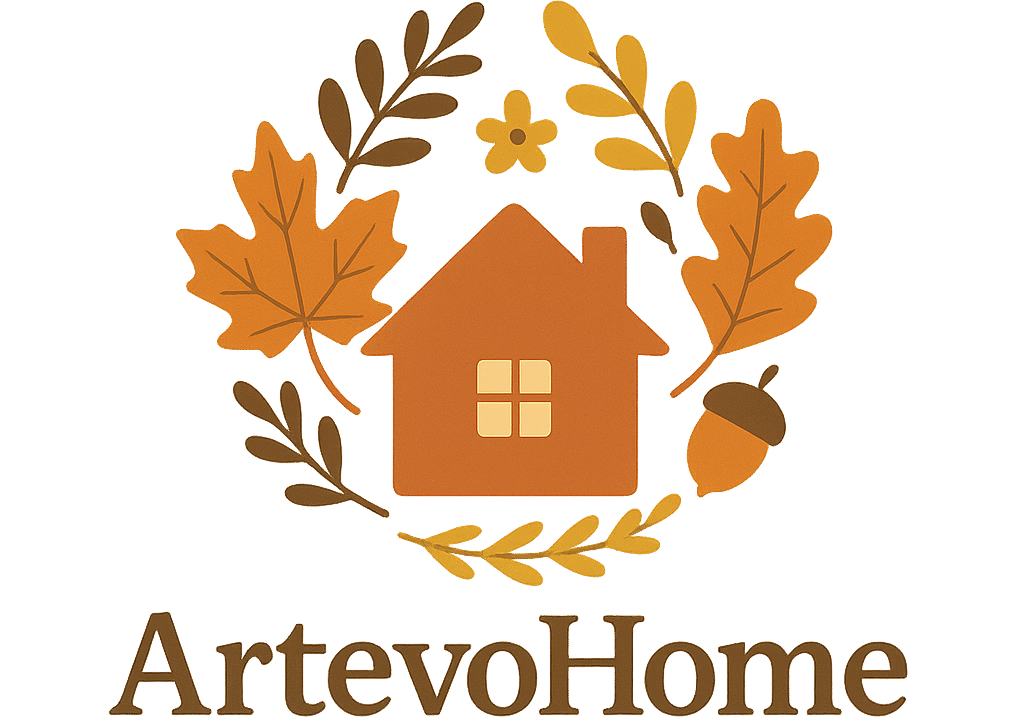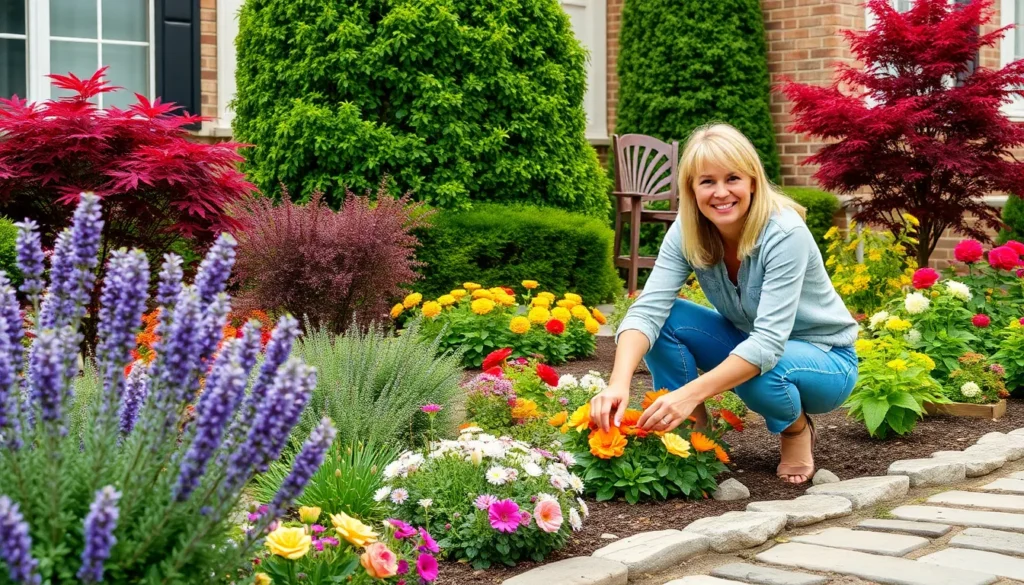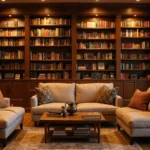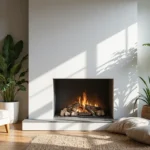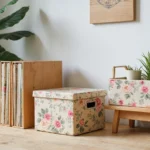Your front yard serves as the first impression visitors get of your home, and we know how important that initial curb appeal can be. Whether you’re looking to boost your property value or simply create a welcoming entrance that reflects your personal style, the right landscaping choices can transform even the most basic front yard into a stunning focal point.
We’ve gathered the most effective and budget-friendly front yard landscaping ideas that work for homes of all sizes and architectural styles. From low-maintenance plant selections to creative hardscaping answers, these proven strategies will help you design an outdoor space that’s both beautiful and functional.
The best part? Most of these landscaping projects can be tackled over a weekend, and many require minimal ongoing maintenance once established. Let’s explore how you can create the front yard of your dreams without very costly or spending countless hours on upkeep.
Create Stunning Curb Appeal With Professional-Looking Foundation Plantings
Foundation plantings serve as the backbone of any successful front yard design, creating a seamless transition between your home’s architecture and the surrounding industry. We’ll show you how to achieve that polished, professional look with strategic plant selection and placement techniques.
Choose Evergreen Shrubs for Year-Round Structure
Evergreen shrubs provide the essential framework that keeps your front yard looking intentional throughout all seasons. Boxwood varieties like ‘Green Velvet’ and ‘Winter Gem’ create clean lines and maintain their compact shape with minimal pruning. Japanese yews offer versatility with their ability to thrive in both sun and shade while providing rich, dark green foliage that complements any home exterior.
Consider dwarf varieties to prevent overgrowth issues that plague many foundation plantings. Dwarf Alberta spruce adds vertical interest without overwhelming smaller homes, while compact holly cultivars like ‘Steeds’ provide year round color with attractive berries. These selections eliminate the need for constant maintenance while delivering professional results.
Rhododendrons and azaleas bring seasonal blooms while maintaining their evergreen structure in most climates. Choose compact cultivars that won’t outgrow their designated spaces, ensuring your investment continues paying dividends for years to come.
Layer Plants by Height for Visual Interest
Layering creates depth and visual complexity that transforms basic foundation plantings into sophisticated industry designs. Start with taller shrubs like viburnum or lilac positioned at corners and larger spaces, then fill middle areas with medium height plants such as spirea or weigela.
Ground level plants complete the layered effect with options like pachysandra, ajuga, or ornamental grasses. This three tier approach mimics natural forest edges while creating opportunities for seasonal color changes throughout the year. Place taller elements first, working downward to ensure proper spacing and light distribution.
Stagger planting distances to create organic curves rather than rigid straight lines. Vary the heights within each layer to avoid the monotonous “bowling ball” effect that screams amateur landscaping. Professional designers use odd numbered groupings of 3, 5, or 7 plants to create natural looking clusters.
Select Native Plants for Easy Maintenance
Native plants establish quickly and require significantly less water, fertilizer, and pest control than non native alternatives. Research your exact region’s native species through local extension offices or native plant societies to identify the best options for your climate zone.
Purple coneflower, black eyed Susan, and native asters provide stunning blooms while supporting local wildlife populations. These perennials return year after year, reducing replacement costs and maintenance time. Native shrubs like serviceberry, elderberry, and native azaleas offer four season interest with spring flowers, summer foliage, fall color, and winter structure.
Incorporate native grasses such as little bluestem or buffalo grass for texture and movement. These selections adapt to local soil conditions without amendments, making them ideal for busy homeowners who want beautiful results without extensive upkeep. Native plant combinations create cohesive designs that look naturally suited to your exact geographic area.
Design Eye-Catching Walkways That Welcome Guests
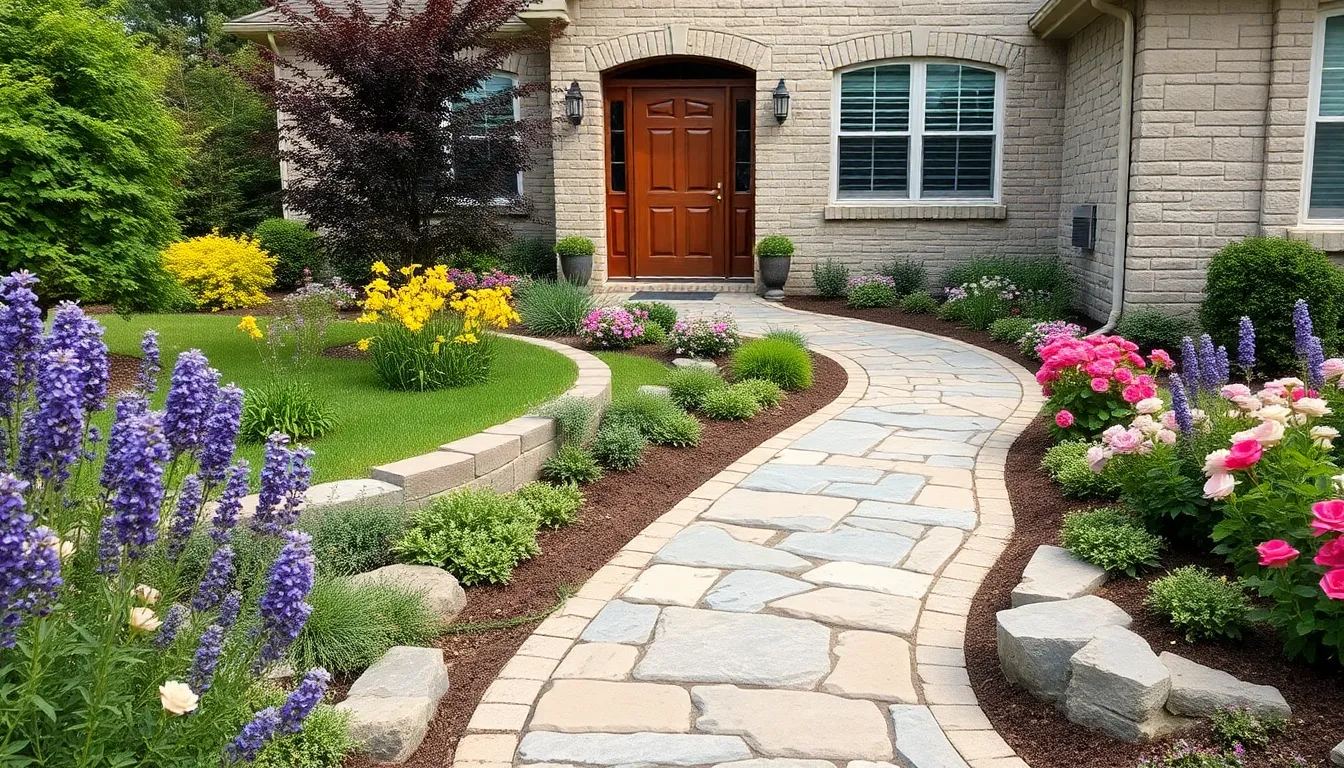
Creating the perfect pathway sets the stage for your entire front yard industry design. Walkways serve as the ribbon that ties together all your landscaping elements while guiding visitors toward your front door.
Install Natural Stone Pathways for Timeless Appeal
Natural stone pathways deliver unmatched durability that withstands years of foot traffic and weather conditions. We recommend materials like brick, stone, or gravel for creating visually appealing pathways that complement any architectural style.
Stone options provide minimal maintenance requirements compared to other walkway materials. Flagstone, limestone, and slate offer classic aesthetics that never go out of style, making them excellent investments for long term curb appeal.
Installation becomes straightforward when you prepare the base properly with sand or gravel. We suggest adding solar powered lights along these stone pathways to create warm and inviting ambiance during evening hours.
Create Curved Walkways to Add Visual Flow
Curved walkways generate a sense of movement and flow that guides visitors naturally through your industry design. These organic shapes create visual interest while making your front yard appear larger and more sophisticated.
Design curved paths to follow the natural contours of your property for the most authentic appearance. We recommend softening the pathway edges by planting small shrubs or flowers along the borders to integrate the walkway seamlessly into your overall industry.
Curved designs work particularly well for larger front yards where straight pathways might appear too rigid or formal. The gentle curves add elegance while creating multiple viewing angles of your carefully planned plantings and garden features.
Border Pathways With Colorful Perennials
Colorful perennials transform ordinary walkways into stunning garden corridors that bloom throughout multiple seasons. We suggest choosing varieties like lavender, roses, or coneflowers for vibrant displays that require minimal ongoing care.
Plant selection should focus on low maintenance perennials that thrive in your exact climate zone. These hardy plants return year after year, providing consistent color and texture without the expense of annual replacements.
Arrange perennials in layered heights along pathway borders to create depth and visual interest. Taller varieties like Russian sage work beautifully in back rows, while compact options such as creeping phlox fill front spaces perfectly.
Transform Your Lawn With Strategic Garden Beds
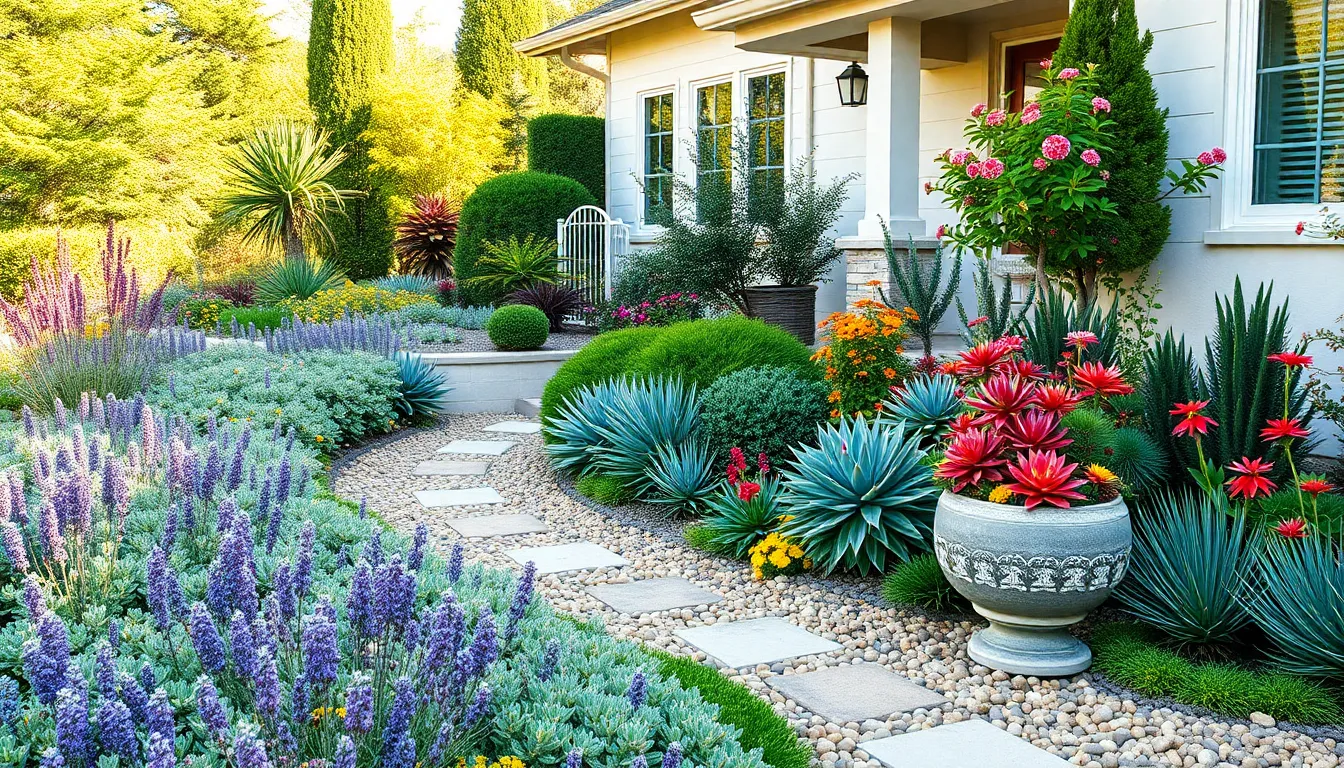
Strategic garden beds transform traditional lawns into ever-changing landscapes that require less maintenance while delivering maximum visual impact. We recommend incorporating diverse plantings that create layered, visually appealing effects throughout your front yard space.
Replace High-Maintenance Grass With Drought-Tolerant Ground Cover
Drought-tolerant ground covers eliminate the need for constant watering and mowing that traditional grass demands. Lavender and cotoneaster serve as excellent alternatives that reduce water consumption while providing year-round texture and color. These low-maintenance options thrive in various soil conditions and require minimal care once established.
Turf-less designs offer complete freedom from grass maintenance altogether. We suggest replacing entire lawn areas with climbing roses, ornamental vines, and layered perennial plantings. This approach creates unique landscapes that showcase diverse plant textures while eliminating weekly mowing schedules.
Container gardens provide flexibility for renters or homeowners who prefer seasonal changes. Large planters filled with drought-resistant succulents, ornamental grasses, and native wildflowers add instant color without permanent ground modifications.
Create Symmetrical Beds for Formal Appeal
Formal landscaping achieves elegant sophistication through symmetrical garden bed placement. Identical plantings positioned on either side of walkways or entrance features create balanced visual harmony that complements traditional home architecture.
Structured plantings work best when we mirror plant selections across central focal points. Japanese maples paired with evergreen shrubs on both sides of your front entrance establish formal symmetry while providing seasonal interest through changing foliage colors.
Archway elements enhance symmetrical designs when covered with climbing roses or flowering vines. These vertical features add height dimension while maintaining the balanced aesthetic that formal gardens require.
Design Asymmetrical Gardens for Modern Landscapes
Modern asymmetrical gardens deliver contemporary appeal through intentionally unbalanced plant arrangements. We recommend mixing varied textures and colors in irregular patterns that create ever-changing visual movement across your front yard industry.
Informal plantings along natural slopes or around existing trees work particularly well for asymmetrical designs. Combining tall ornamental grasses with low-growing perennials and scattered shrubs creates organic flow that feels naturally evolved rather than formally planned.
Diverse plant combinations featuring contrasting heights, leaf shapes, and bloom times ensure year-round interest in asymmetrical gardens. Grouping plants in odd numbers and varying their spacing creates the relaxed, modern aesthetic that many homeowners prefer over traditional formal arrangements.
Add Vertical Interest With Trees and Tall Elements

Creating height and layered dimension prevents flat or uninspiring looks in your front yard design. Upright features such as trees, arbors, arches, pergolas, and obelisks transform yards lacking mature trees or hedges into visually compelling landscapes.
Plant Ornamental Trees as Focal Points
Ornamental trees serve as natural anchors that provide year-round interest and structure to your industry design. We recommend selecting varieties based on colorful foliage, seasonal flowers, or attractive bark patterns that complement your home’s architecture. Popular choices include Japanese maples for their stunning fall colors, dogwoods for spring blooms, and birch trees for distinctive white bark that adds winter appeal.
Position these focal point trees strategically to frame your home’s entrance or create privacy screens from neighboring properties. Small ornamental varieties work perfectly in compact spaces, while larger specimens can anchor corner plantings or define property boundaries. Consider the mature size when planting to ensure adequate spacing and prevent overcrowding as trees develop.
Install Decorative Trellises for Climbing Plants
Trellises are flat structures made of wood or metal that support climbing plants while maximizing vertical growing space. We suggest using them for ivy, roses, grapevines, and clematis that create living walls with minimal ground footprint. These structures enable dramatic height additions in narrow spaces between houses or along fence lines.
Choose materials that complement your home’s style, from rustic cedar lattice to sleek metal panels that support different climbing plant weights. Install trellises against walls, fences, or as freestanding garden features that divide outdoor spaces. Climbing plants on trellises improve air quality and attract pollinators like bees and butterflies to your front yard network.
Use Tall Grasses for Movement and Texture
Tall ornamental grasses contribute ever-changing movement and soft textures that contrast beautifully with rigid architectural elements. We recommend varieties like switchgrass, maiden grass, and miscanthus for their low maintenance requirements and seasonal adaptability. These grasses sway gracefully with wind patterns, creating ever-changing visual displays throughout the growing season.
Plant tall grasses in clusters or borders to maximize their textural impact and create natural privacy screens. Their vertical growth patterns add instant height to flat landscapes while requiring minimal water once established. Many ornamental grasses provide winter interest through dried seed heads and golden foliage that persist through cold months.
Incorporate Hardscaping Elements for Structure and Function
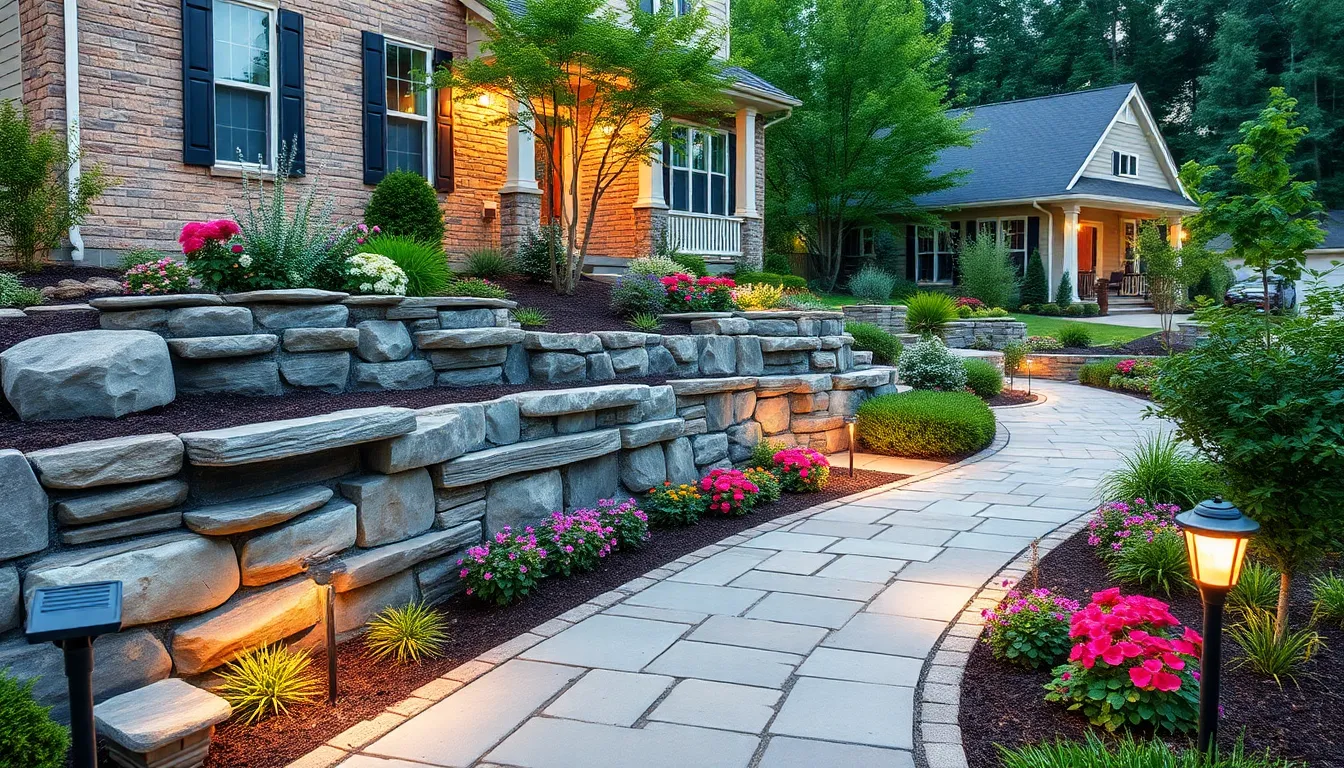
Hardscaping elements transform our front yards from simple plantings into sophisticated outdoor spaces. These structural features provide the foundation that makes our landscaping look professionally designed and purposeful.
Build Retaining Walls for Sloped Properties
Retaining walls solve the challenge of sloped properties while creating valuable flat planting areas. We can construct these walls using stone, brick, or concrete blocks depending on our home’s architectural style and budget. Properties with slopes benefit significantly from retaining walls as they provide essential structural support and prevent soil erosion during heavy rains.
Creating terraced levels with retaining walls allows us to plant different garden zones at various heights. Stone retaining walls offer the most natural appearance and blend seamlessly with surrounding industry elements. Concrete block walls provide the most affordable option while still delivering excellent functionality for homeowners working within tight budgets.
Add Decorative Borders With Natural Materials
Natural materials like wood, stone, and brick create clean edges that define our garden spaces beautifully. We can arrange these materials in various patterns to develop visually appealing borders around flower beds and walkways. Stone borders provide permanent answers that require minimal maintenance once properly installed.
Wood borders offer flexibility for seasonal changes and work particularly well around curved garden beds. Brick edging creates formal appearances that complement traditional home styles and established neighborhoods. Natural stone arranged in irregular patterns develops organic looks that feel more relaxed and cottage-like.
Install Outdoor Lighting for Safety and Ambiance
Outdoor lighting serves dual purposes by improving safety while highlighting our industry’s best features. We should illuminate walkways to prevent accidents and guide visitors safely to our front entrance. Path lighting creates dramatic effects that showcase our hardscaping investments after dark.
Solar-powered lights offer energy-efficient options that require no electrical work or ongoing utility costs. Uplighting positioned near trees and architectural features creates stunning nighttime focal points. Low-voltage LED systems provide professional results while maintaining reasonable installation and operating expenses for most homeowners.
Enhance Your Front Entrance With Container Gardens
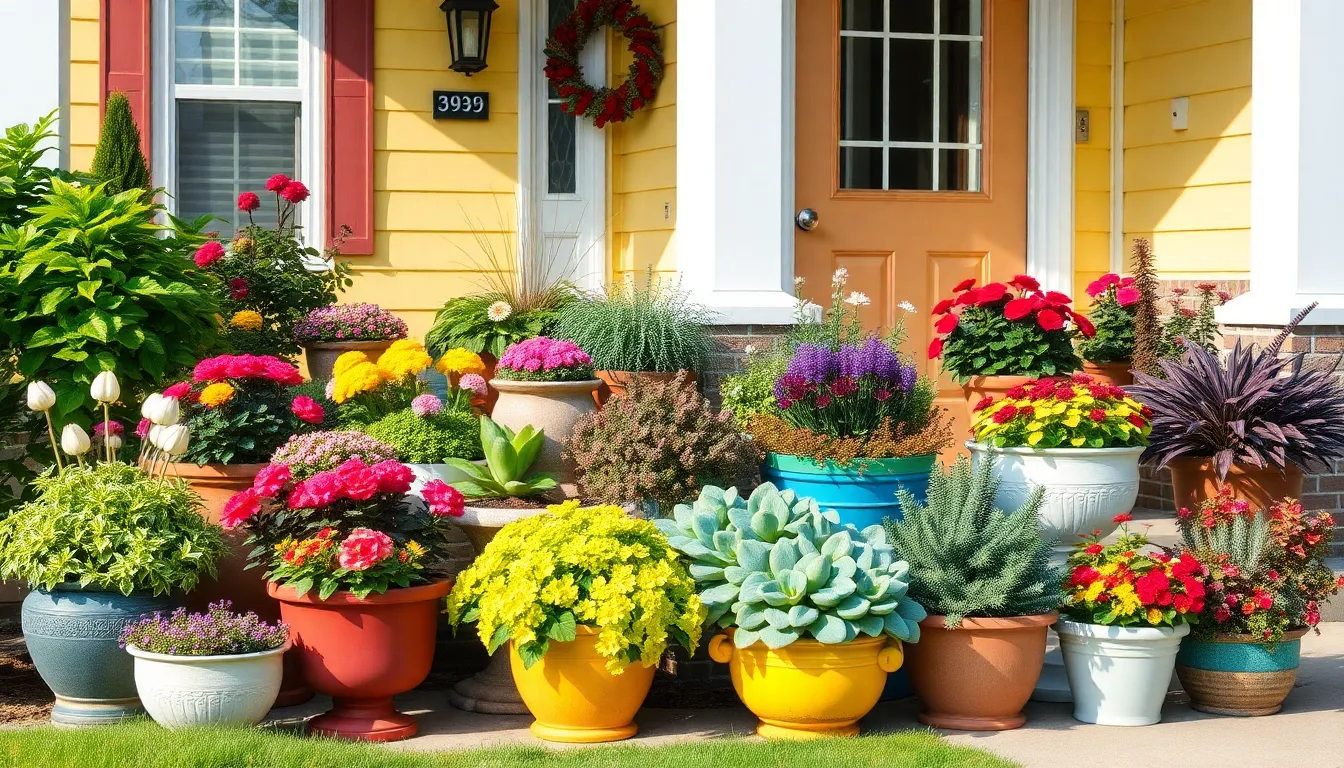
Container gardens offer the perfect solution for adding instant color and sophistication to your front entrance without committing to permanent plantings. We can transform our entryway with strategic container arrangements that create focal points and welcome guests with vibrant displays.
Choose Weather-Resistant Planters
Selecting durable planters ensures our container gardens withstand seasonal weather changes while maintaining their aesthetic appeal. Ceramic planters provide excellent insulation for plant roots and resist cracking in moderate climates. Wood containers offer natural beauty and can be treated to resist moisture damage and insect infestation. Plastic planters deliver the most weather resistance at budget-friendly prices and come in styles that mimic expensive materials like stone or ceramic.
We recommend avoiding thin-walled materials that crack during freeze-thaw cycles. Quality planters with drainage holes prevent waterlogged soil that kills plants during wet seasons. Investing in weather-resistant containers saves money long-term by eliminating frequent replacements.
Create Seasonal Displays That Change Throughout the Year
Seasonal rotations keep our front entrance fresh and captivating throughout every season. Spring displays should feature early-blooming bulbs like crocuses that provide vibrant color when most plants remain dormant. Summer arrangements shine with full-sun annuals like Wave petunias and million bells that bloom continuously in hot weather.
Fall containers can showcase ornamental cabbage and coleus for warm, inviting autumn colors that complement changing foliage. Winter displays rely on evergreen plants like boxwood shrubs and topiaries that maintain structure and beauty during dormant months.
We can also incorporate seasonal accessories like pinecones, seasonal berries, or holiday decorations to enhance our displays without replanting entirely. This approach maximizes visual impact while minimizing maintenance throughout the year.
Group Containers in Odd Numbers for Visual Balance
Arranging containers in groups of three or five creates more visually appealing displays than even-numbered groupings. Odd-numbered arrangements naturally draw the eye and feel more balanced to human perception. We should vary container heights within each grouping to add depth and prevent monotonous straight lines.
Mixing different shapes like round pots with rectangular planters adds visual interest while maintaining cohesion through consistent materials or colors. Large containers work best as anchor pieces with smaller pots clustered around them for layered displays.
We can enhance these groupings by using elephant’s ear as dramatic backdrop plants surrounded by colorful flowers for contrasting textures. Waxleaf privet topiaries, creeping Jenny, and variegated English ivy create sophisticated combinations when paired with seasonal annuals. Rustic containers like galvanized buckets mixed with contemporary planters add personality and prevent overly formal appearances.
Establish Privacy and Boundaries With Living Screens
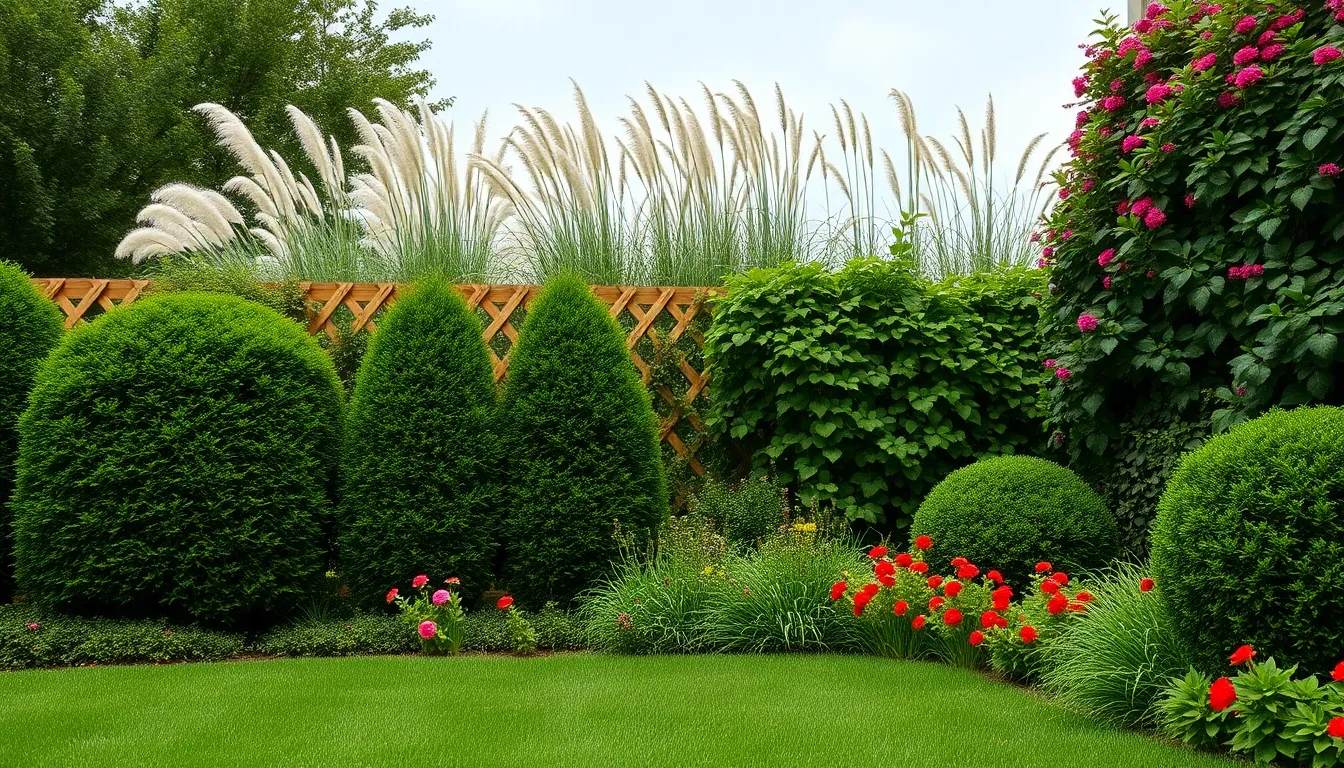
Creating natural barriers in your front yard doesn’t require expensive fencing when you can use strategic plantings. Living screens offer both privacy and beauty while softening harsh architectural lines.
Plant Hedges for Natural Fencing
Dense hedges provide natural barriers that define your property boundaries while creating year-round structure. Boxwood and arborvitae species work exceptionally well for these purposes because they maintain their fullness throughout all seasons. We recommend planting these evergreen options in a straight line along property edges or curved patterns to follow your industry’s natural flow.
Mixed plantings combine functionality with visual appeal by incorporating both evergreen and flowering shrubs into your hedge design. This approach gives you privacy benefits while adding seasonal color changes to your front yard. Consider alternating boxwoods with flowering shrubs like forsythia or hydrangeas to create a ever-changing living fence that evolves throughout the growing season.
Use Ornamental Grasses to Define Spaces
Tall grasses create natural screens that move gracefully in the breeze while providing excellent privacy coverage. Pampas grass and bamboo varieties reach impressive heights and form dense clusters perfect for blocking unwanted views. These grasses require minimal maintenance once established and offer textural interest that complements other industry elements.
Layered landscaping uses ornamental grasses as the foundation for more complex privacy answers. Position tall grasses as your backdrop, then add medium-height shrubs in front, finishing with lower perennials at ground level. This three-tier approach creates depth and concealment while ensuring your privacy screen looks intentional rather than haphazardly planted.
Install Lattice Panels With Climbing Vines
Lattice panels provide immediate structure for climbing plants while offering instant privacy answers. Wisteria and morning glory vines quickly cover these supportive frameworks, creating living walls that change with the seasons. We suggest choosing weather-resistant lattice materials like cedar or vinyl to ensure longevity in your climate conditions.
Decorative screens function as living canvases when paired with vigorous climbing plants like ivy or clematis. These installations work particularly well along fence lines or as standalone features that divide different areas of your front yard. The combination of architectural elements with natural growth creates sophisticated privacy answers that enhance your home’s curb appeal.
Design Water Features That Create Tranquil Focal Points
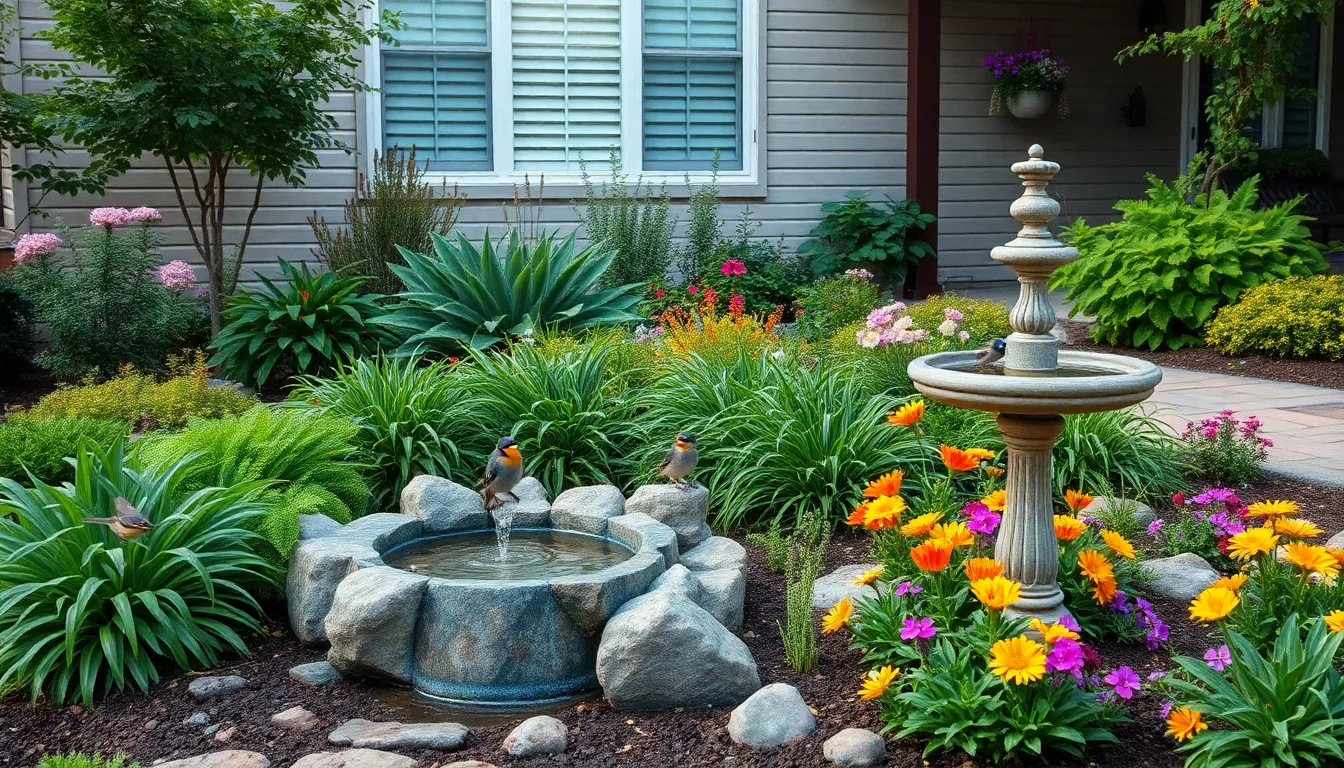
Water features transform front yards into peaceful retreats while serving as stunning visual anchors that draw attention and complement your home’s architecture.
Install Small Fountains for Soothing Sounds
Small fountains provide gentle water flow that masks urban noise and creates a relaxing atmosphere in your outdoor space. Wall-mounted models work perfectly for compact areas, while free-standing fountains can serve as centerpieces in larger yards. Materials like stone, ceramic, and metal offer various design options that complement both contemporary and traditional home styles.
Position fountains near seating areas or entryways to maximize their calming effect on guests and family members. The continuous sound of moving water has been proven to promote relaxation and make outdoor spaces more enjoyable. Many homeowners find that even compact fountain models on patios or balconies create important impact without requiring extensive installation.
Create Rain Gardens for Sustainable Drainage
Rain gardens are shallow planted depressions that absorb and filter stormwater runoff, reducing water pollution while preventing erosion around your property. These sustainable features work by directing water away from structures into moisture-loving plants that thrive in temporarily wet conditions. Position rain gardens in naturally low-lying areas of your front yard to take advantage of existing water flow patterns.
Native plants like cardinal flower, swamp milkweed, and blue flag iris excel in rain garden environments while supporting local pollinators. These gardens require minimal maintenance once established and provide habitat for beneficial insects throughout the growing season. Homeowners can significantly reduce their industry’s environmental impact while creating beautiful focal points that change with seasonal rainfall patterns.
Add Birdbaths to Attract Local Wildlife
Birdbaths serve as essential water sources that attract birds, beneficial insects, and other wildlife to your front yard industry. These simple additions provide ever-changing visual interest as different species visit throughout the day, creating natural entertainment for homeowners and guests. Regular maintenance with fresh, clean water ensures healthy wildlife interactions and prevents mosquito breeding.
Strategic placement near shrubs or trees gives birds safe perching spots while making the birdbath a natural part of your industry design. Shallow basins work best for smaller songbirds, while deeper models accommodate larger species and provide drinking water during dry periods. Many wildlife experts recommend positioning birdbaths where you can easily observe visiting animals from indoor spaces like kitchen windows or living rooms.
Choose Color Schemes That Complement Your Home’s Architecture
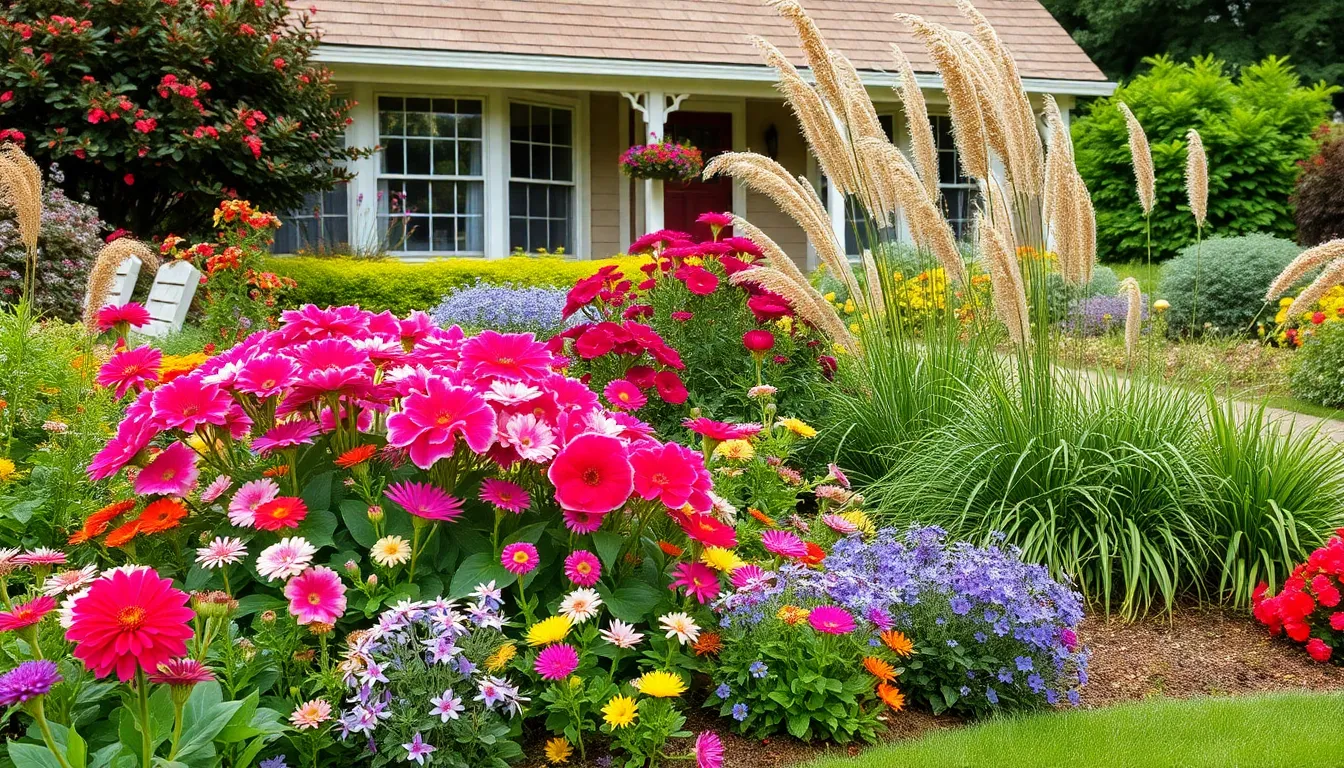
Creating visual harmony between your front yard landscaping and your home’s architectural style forms the foundation of exceptional curb appeal. Modern homes benefit from minimalist green foliage and neutral color palettes, while cottage-style properties shine with vibrant, multi-layered flower arrangements that enhance their charming character.
Select Plants That Bloom in Succession
Incorporating plants that flower at different times throughout the growing season ensures continuous color and interest in your front yard industry. We recommend combining perennials like early spring tulips, summer black-eyed Susans, and fall chrysanthemums with annuals such as petunias and marigolds for staggered blooming periods. This strategic approach creates a ever-changing and evolving industry that maintains visual appeal from spring through fall.
Planning your succession planting requires understanding bloom times in your exact region. Early bloomers like crocuses and daffodils provide initial spring color, followed by mid-season favorites such as peonies and iris. Late-season performers including asters and ornamental kale extend the display well into autumn, ensuring your front yard never lacks visual interest.
Coordinate Flower Colors With Your Home’s Exterior
Choosing flower colors that either match or provide striking contrast to your home’s facade creates exceptional visual impact and enhances overall curb appeal. We suggest pairing warm home colors like reds and yellows with cooler flower tones such as blues and purples for dramatic contrast, or maintaining harmony through consistent color families that tie directly to your architectural style.
Neutral-colored homes offer the greatest flexibility for flower color selection, allowing bold choices like bright orange marigolds or deep purple salvias. Traditional brick homes pair beautifully with white and yellow blooms such as roses and daylilies, while contemporary gray exteriors complement purple lavender and pink flowering shrubs perfectly.
Consider your home’s trim colors when selecting flower palettes, as these details can guide your choices for maximum coordination. White trim allows virtually any flower color to shine, while darker trim benefits from lighter, brighter blooms that create appealing contrast against the structure.
Use Foliage Plants for Consistent Color Throughout Seasons
Incorporating evergreen shrubs and ornamental grasses provides reliable color and structure throughout the year, ensuring your industry remains attractive when flowers aren’t in bloom. We recommend mixing evergreen ground covers like pachysandra and vinca with flowering plants for a low-maintenance, year-round appearance that delivers consistent visual appeal.
Foliage plants offer stability and backbone to your industry design, serving as permanent fixtures around which seasonal displays can rotate. Boxwoods provide classic green structure, while colorful options like Japanese barberry add burgundy tones, and hostas contribute varied leaf patterns and textures to shaded areas.
| Plant Type | Season Appeal | Maintenance Level | Color Contribution |
|---|---|---|---|
| Evergreen shrubs | Year-round | Low | Consistent green structure |
| Ornamental grasses | Spring through winter | Very low | Movement and texture |
| Colorful foliage plants | Three seasons | Low to moderate | Seasonal color variation |
| Ground covers | Year-round | Very low | Uniform base coverage |
Ornamental grasses like fountain grass and Japanese forest grass add movement and texture while requiring minimal care throughout the growing season. These plants maintain their structure through winter months, providing visual interest even when dormant and creating natural boundaries between different industry zones.
Maintain Your Front Yard Landscaping for Long-Term Success
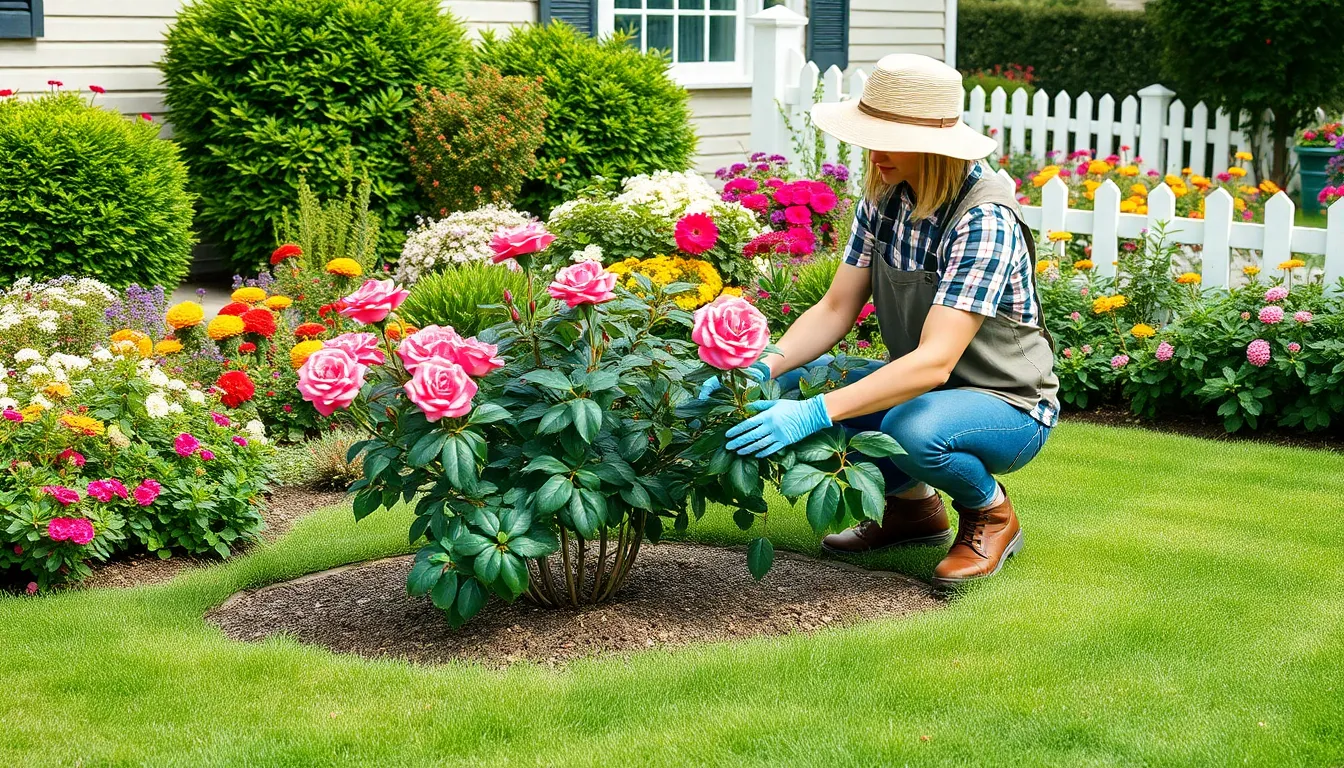
Creating a stunning front yard design is just the beginning. Proper maintenance ensures your landscaping investment continues to enhance your home’s curb appeal for years to come.
Establish Regular Watering and Fertilizing Schedules
Consistent moisture and nutrients help plants establish roots and resist pests or disease. We recommend setting up automatic irrigation systems or soaker hoses to deliver water directly to plant roots without wasting resources on hardscaping elements.
Watering schedules should adapt to seasonal changes and plant needs. Spring plantings require more frequent watering as they establish root systems, while mature perennials and shrubs need deep, less frequent watering sessions. Summer months demand early morning irrigation to reduce evaporation and prevent leaf scorch.
Fertilizing programs boost plant health and vibrancy throughout growing seasons. Apply slow-release fertilizers in early spring for consistent nutrient delivery, then supplement with liquid fertilizers during peak growing periods. Native plants typically require less fertilization than non-native varieties, making them excellent choices for low-maintenance front yard designs.
Soil testing reveals exact nutrient deficiencies before problems appear. Test pH levels annually to ensure optimal growing conditions for your chosen plant combinations. Amend soil with organic compost to improve drainage and nutrient retention in garden beds.
Plan for Seasonal Pruning and Plant Care
Seasonal pruning maintains plant shape and promotes healthy growth while removing dead or diseased foliage. Spring pruning sessions focus on shaping deciduous shrubs and removing winter damage from perennials. Summer maintenance includes deadheading spent blooms and controlling rapid growth in climbing roses and ornamental grasses.
Timing proves crucial for successful pruning results. Prune spring-flowering shrubs immediately after blooms fade to avoid removing next year’s flower buds. Fall pruning should be minimal, focusing only on removing damaged branches that could break under snow or ice loads.
Tool maintenance ensures clean cuts that heal properly. Sharp, sterilized pruning shears prevent disease transmission between plants and create wounds that close quickly. Clean tools with rubbing alcohol between different plant species to avoid spreading pathogens.
Mulching around plants reduces weeding time and retains soil moisture. Apply 2-3 inches of organic mulch around trees, shrubs, and perennial beds each spring. Keep mulch away from plant stems to prevent pest harboring and root rot issues.
Monitor and Replace Plants as They Mature
Plant maturity monitoring prevents overcrowding and maintains industry balance. We observe how plants grow over time, noting which specimens outcompete others or exceed their intended space allocations. Japanese maples and ornamental trees may need relocation as they mature and require more growing room.
Replacement planning keeps front yard designs fresh and functional. Plants that become overgrown, lose their vitality, or no longer suit the industry design should be replaced with appropriate alternatives. Consider upgrading to newer cultivars that offer improved disease resistance or extended blooming periods.
Growth pattern assessment guides future planting decisions. Document which plants thrive in exact locations and which struggle with local growing conditions. This information helps us make better choices when selecting replacement plants or expanding existing garden beds.
Routine care ensures your front yard remains attractive and manageable over time. Weekly walkthrough inspections help identify problems before they become serious issues. Early intervention saves both time and money while keeping your industry looking professionally maintained year-round.
Conclusion
Transforming your front yard doesn’t have to be overwhelming or expensive. With these landscaping ideas we’ve shared you can create stunning curb appeal that reflects your personal style while staying within budget.
The key to success lies in choosing the right combination of elements for your exact space and climate. Whether you opt for native plantings water features or modern hardscaping each choice should work together to create a cohesive design.
Remember that great landscaping is an investment in your home’s value and your daily enjoyment. Start with one or two projects that excite you most and build from there. Your front yard transformation awaits!
Frequently Asked Questions
What are the best low-maintenance plants for front yard landscaping?
Evergreen shrubs like boxwoods and Japanese yews are excellent choices for year-round structure and minimal upkeep. Native plants are also ideal as they require less water and care while supporting local wildlife. Consider drought-tolerant ground covers like lavender and cotoneaster, which reduce water consumption and provide consistent texture throughout the seasons.
How can I create an attractive walkway on a budget?
Natural stone pathways using brick, stone, or gravel offer durability and timeless appeal without breaking the bank. Focus on proper base preparation for installation and consider adding solar-powered lights for evening ambiance. Curved walkways can make your front yard appear larger and more sophisticated than straight paths.
What’s the three-tier approach for foundation plantings?
The three-tier system involves layering plants by height to create visual depth and interest. Place taller shrubs in the back, medium-height plants in the middle, and ground cover in front. This creates a professional-looking foundation that serves as the backbone of your front yard design.
How do I choose between formal and modern landscaping styles?
Formal gardens feature symmetrical arrangements and balanced plant placements for elegant sophistication. Modern asymmetrical gardens use intentionally unbalanced arrangements for organic flow and contemporary appeal. Choose based on your home’s architecture and personal preference—both styles can incorporate diverse plant combinations for year-round interest.
What are some effective ways to add vertical interest to my front yard?
Plant ornamental trees like Japanese maples, dogwoods, or birch trees as focal points. Install decorative trellises for climbing plants to create living walls and maximize vertical space. Tall ornamental grasses add movement and texture while requiring minimal maintenance, preventing your landscape from looking flat or uninspiring.
How can water features enhance my front yard landscaping?
Small fountains provide soothing sounds and visual appeal, available in various materials to complement your home’s style. Rain gardens offer sustainable stormwater management using native plants. Birdbaths attract local wildlife, providing natural entertainment and beauty while supporting your local ecosystem with minimal maintenance requirements.
What maintenance schedule should I follow for my front yard?
Establish regular watering and fertilizing schedules using slow-release fertilizers for optimal plant health. Perform seasonal pruning and monitor plant maturity to prevent overcrowding. Consider automatic irrigation systems and adapt watering schedules to seasonal changes. Conduct routine inspections to identify and address issues early for long-term success.
How do I coordinate colors with my home’s exterior?
Modern homes benefit from minimalist foliage designs, while cottage-style properties shine with vibrant flower arrangements. Choose plants that bloom in succession using a mix of perennials and annuals for continuous color. Match or contrast flower colors with your home’s exterior paint and incorporate evergreen foliage for year-round structure.
